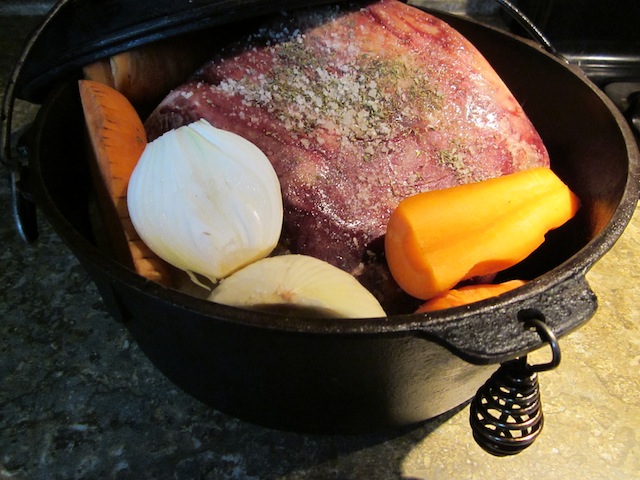
A Dutch oven is best for long, slow cooking. It will take the toughest cut of meat and make it fall off the bone. It works like a crock pot in the oven. These case iron pots will last for generations, making it a good choice for someone wanting to reduce their carbon footprint.
Over the winter I have found my Mother’s Dutch oven to be indispensable. This bare cast iron pot has a wire bail handle. On one side of the pot is a coiled wire handle which helps lift this heavy pot when full. With the help of a tightly fitted lid this pot is useful for many types of cooking. It can be used on top of the stove for frying or boiling or in the oven like a covered casserole dish for slow roasting. I have never used it for baking, but the pot and lid can be used over an open fire as an “oven” for baking biscuits, breads and cakes. It is a wonderful, versatile kitchen implement. I cannot remember a time when this pot was not in my Mother’s kitchen. It may have been a wedding present which would make it almost sixty years old. It is in perfect condition after years of heavy use. I will be giving this pot to my children.
In my vegetarian days, I found I didn’t like cast iron because I found seasoning with vegetable oils produced a gluey residue on the fry pans or pots. (I didn’t know that if I had used traditional fats like lard, schmaltz, or tallow, I would never have had problems with my Mother’s cast iron pots and pans. Of course, I wouldn’t have used animal fats because I was a vegetarian.) So, I moved away from my Mother’s cast iron pots for two decades and became a consumer of non-stick fry pans and stainless steel pots.
In the last few years, as I have learned more about nourishing traditional foods, I have removed all the non-stick pans from my kitchen. I still use my stainless steel pots and pans, but they don’t do a great job in the oven. I started using glassware for the oven which works well for quick baking but doesn’t do a good job at slow roasting. I still had my bias against cast iron from my vegetarian days and heard that enameled cast iron did not stick as much as cast iron. So I bought a number of Le Creuset enameled Dutch ovens. These are very nice pots but they are very expensive. I bought them as seconds so the price wasn’t as bad but most people would find the price excessive.
This winter my sister brought out our Mother’s old iron pots and pans. Since we do not have vegetable oils in the house, the old cast iron was seasoned with lard, schmaltz, and tallow from my grease bucket. Lo and behold the bare cast iron did not stick. A few of the old cast iron pots still had the sticky residue from old vegetable oils which took some time to remove. Once the old vegetable oil was removed, the old iron fry pan would became slick and easy to clean from the animal fats.
It is funny how our actions can have unintended results. Becoming a vegetarian made my Mother’s iron pots and pans not work for me. I became a consumer of Teflon pots, pans and baking trays which I needed to throw out every few years as they got scratched up. Many people discard grandma’s iron pots and pans because of sticking, not knowing that this modern problem is caused by industrial vegetable oils. In the end, the Vegetable Oil Companies created a new industry for non-stick pots and pans. This started our society’s love affair with Teflon with all its related health problems. Do as your grandmother did and her iron pots and pans will last a lifetime. Maybe even several lifetimes. For more information about collecting your own animal fats please read The Great Grease Bucket: Something from Nothing.
?Something from Nothing? is what a frugal housewife would get when she went to the trouble to save drippings from roasted meats, sausages and bacon. ?Something from Nothing? is what the Vegetable Oil Companies created when they convinced everyone that the grease bucket was unhealthy and would cause disease or possibly death.
So, if you are interested in nourishing traditional foods and saving money, go to your local garage sale and pick up a load of dusty old cast iron pots and pans that someone is throwing out. Save your drippings from roasted meats, sausages and bacon and use your grease bucket to season your cast iron pots. You will be shocked at how slick your cast iron will become. Here are instructions for seasoning your pans. Just remember, use animal fat. NEVER use industrial vegetable oils.
